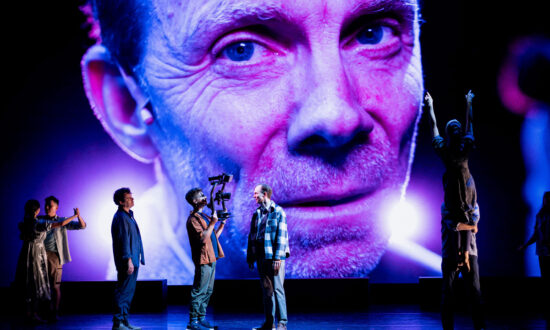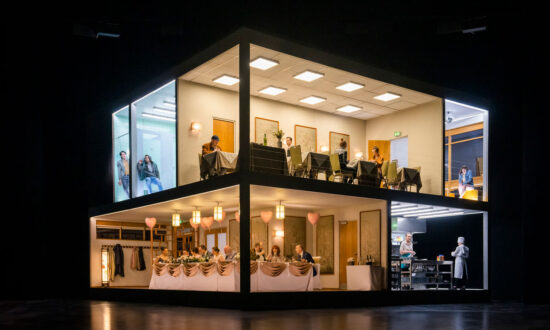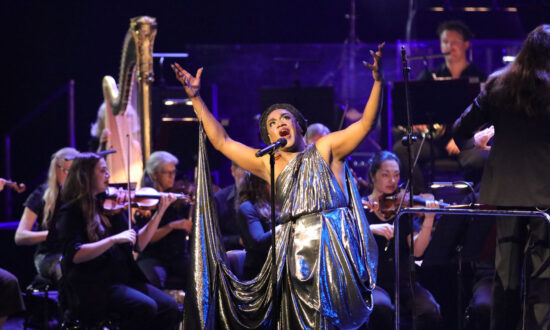James Newitt, Haven
Emily Wardill, Night for Day
Presented by Samstag Museum, at Adelaide Railway Station
The writer Eugene Thacker said that “The world is increasingly unthinkable – a world of planetary disasters, emerging pandemics, tectonic shifts, strange weather, oil-drenched seascapes, and the furtive, always-looming threat of extinction. In spite of our daily concerns, wants, and desires, it is increasingly difficult to comprehend the world in which we live and of which we are a part. To confront this idea is to confront an absolute limit to our ability to adequately understand the world at all.”
Sometimes it takes visual art and perhaps poetry to frame an adequate response to this line of thought.
Two short films, Haven by James Newitt and Night for Day by Emily Wardill – Samstag Museum’s current Adelaide Festival offering, showing in the north-eastern concourse at Adelaide Railway Station – are engaged with aspects of this sense of belonging, or not, to the world.
The two works share some common ground. Newitt, a UniSA Samstag Scholar in 2012-13, lives and works in Hobart and Lisbon, Portugal. Features of his practice are extended research into specific social cultural and environmental situations, and the development of ongoing relationships with individuals and communities. UK artist Wardill lives and works in Lisbon and Malmo, Sweden. Her films, photographs and objects explore aspects of perception and communication, and the role of the imagination in constructions of reality.
Newitt invited Wardill to exhibit alongside him at the Adelaide Festival, and their films share a sense of narrative. Newitt has sourced online archives and print documents concerning the creation of a micro-nation in the 1960s when an abandoned World War II gun platform (HM Fort Roughs) was appropriated by a certain Paddy Roy Bates, and proclaimed a principality named Sealand. Along with other decommissioned North Sea gun platforms, this structure had been famous as a pirate radio station.

The Newitt screening is accompanied by two display cases containing archival material collected by the artist during his research. Photo: Sia Duff / Supplied
Haven delivers like a finger-snapping doco – sexy drone takes, jump cuts and savvy interplays between close-ups, zooms and pull-backs. The artist must have climbed all over this rig. But, breaking news, Newitt has never been there and has no intention of going. His proposition is that this place is as much a figment as a physical site. In his crosshairs is the idea of someone wanting to create a utopia as a way of living in the world.
Newitt’s persuasive, visual reconstruction of Sealand from public domain sources is itself a metaphor for the way in which we construct some kind of reality to fuel dreams. He moves his visual modules like chess pieces, constructing a game-plan that takes the viewer to an end-point beyond the heaving seas that threaten to swallow this impertinent skerrick of human invention, towards the kind of future that Thacker foresees – technology in alliance with nature. And if humanity cannot cope, then move aside.
The close-out images of nitrogen-filled steel data containers, installed by Microsoft, slumbering peacefully on the ocean floor (data centres), reads as a utopian dream of data security. So the future is in good hands? Our data can live on even though we’ve all gone. What a comforting thought.

James Newitt’s Haven ‘delivers like a finger-snapping doco’. Photo: Sia Duff / Supplied
Wardill’s Night for Day also presents as a narrative of sorts. It is a blend of fact and fiction – comprising a fake mother-son relationship between three real people living in contemporary Lisbon. The “mother” is the legendary Isabel do Carmo, who co-ran the Revolutionary Brigades in Portugal that helped to overthrow the longest fascist dictatorship in Europe, and the “sons” are two young men, Alexander Bridi and Djelal Osman – astrophysicists running a start-up in Lisbon exploring the possibilities of programmed computers recognising moving images. The complexity of this narrative is matched by Wardill’s use of a wide range of cinematic collage techniques to convey states of mind associated not only with the fear and strategies of conducting life under a dictatorship but the challenge of consigning hard-won political lessons to an emerging generation.
Without the constant presence of voice-overs, this film would have made little sense to anyone unfamiliar with the bitter experiences of generations of Portuguese living under the Estado Novo of Antonio Salazar’s regime (1933-1974). But even with a working knowledge of this period of Portuguese history, the challenge to reconcile the fictive elements and the collage of images dominated by darkness and occasional illumination is substantial.

Night for Day, by Emily Wardill, is a blend of fact and fiction. Photo: Sia Duff / Supplied
The common ground that Night for Day shares with Haven may assist. Both films are to some degree about the idea of utopia. Newitt’s micro-nation of Sealand represents a dream of freedom from state authority. Isobel do Carmo’s narration describes attempts by resistance groups to create a new society, a utopia. Bridi and Osman’s enterprise, the invention of new technologies to capture and re-animate moving images, also speaks of a new world order in which computer simulation games technology (machinisma) are redefining perceptions of reality.
The artifice of fake conversations in a context of emerging reality-bending technologies underscores the unstable nature of this cross-generational, shared dream of a better society. Treat Night for Day as an immersive tone-poem and go with the flow of imagery, otherwise you’ll be searching for a formal narrative that doesn’t exist.
Newitt and Wardill’s works look very much at home in the post-industrial confines of the Adelaide Railway Station’s former admin spaces. Adelaide has a strong tradition of demanding that its art audiences sometimes let go the bland assurances of the white cube and walk on the wild side. Perhaps this space, which has some in-your-face attitude, much like Sydney’s Carriageworks, can continue to fulfil this role, post-Festival.

Get InReview in your inbox – free each Saturday. Local arts and culture – covered.
Thanks for signing up to the InReview newsletter.
James Newitt’s Haven and Emily Wardill’s Night for Day are showing in the north-eastern concourse at Adelaide Railway Station after being relocated due to a burst water pipe at the Samstag Museum. The exhibitions run until March 18 as part of the Adelaide Festival program.
Read more Adelaide Festival coverage here on InReview.
Support local arts journalism
Your support will help us continue the important work of InReview in publishing free professional journalism that celebrates, interrogates and amplifies arts and culture in South Australia.
Donate Here




